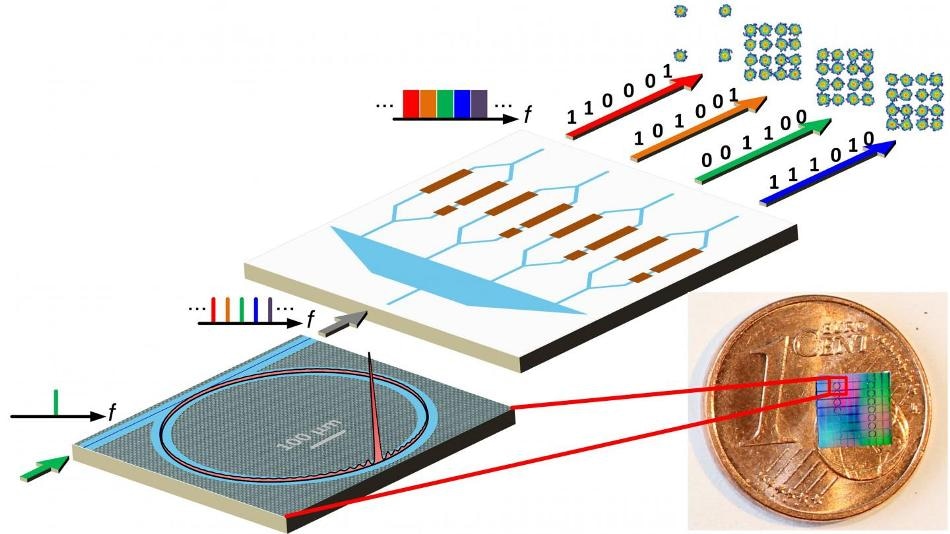Jun 9 2017
A new record for optical data transmission has been set by Researchers at Karlsruhe Institute of Technology (KIT) and École Polytechnique Fédérale de Lausanne (EPFL).
Based on the reports published in Nature, the Research team exploits optical solitons circulating in silicon nitride microresonators in order to produce broadband optical frequency combs. Two such superimposed frequency combs allow huge parallel data transmission on 179 wavelength channels at a data rate greater than 50 terabits per second.
 Soliton frequency combs, generated in silicon nitride microresonators, are used for massively parallel data transmission via various frequency channels (Photo: J. N. Kemal/ P. Marin-Palomo/ KIT)
Soliton frequency combs, generated in silicon nitride microresonators, are used for massively parallel data transmission via various frequency channels (Photo: J. N. Kemal/ P. Marin-Palomo/ KIT)
Optical solitons are considered to be special wave packages that propagate without causing any change to their shape. In optical communications, it is possible to use solitons for generating frequency combs with different spectral lines, which help in realizing specifically compact and efficient high-capacity optical communication systems. This was recently demonstrated by Researchers from KIT’s Institute of Photonics and Quantum Electronics (IPQ) and Institute of Microstructure Technology (IMT) together with Researchers from EPFL’s Laboratory of Photonics and Quantum Measurements (LPQM).
Based on the reports in Nature, the team used silicon nitride microresonators that can be effortlessly incorporated into compact communication systems. Solitons circulate continuously within these resonators, thus producing broadband optical frequency combs. John Hall and Theodor W. Hänsch were awarded the Nobel Prize in Physics in 2005 for such frequency combs, which contain a multitude of spectral lines aligned on a standard equidistant grid. Frequency combs traditionally serve as high-precision optical references for measuring frequencies. Kerr frequency combs feature greater optical bandwidths together with rather bigger line spacings and are considered to be specifically ideal for data transmission. It is possible to use each separate spectral line for transmitting a separate data channel.
Two interleaved frequency combs were used by the Researchers from Karlsruhe and Lausanne in their experiments in order to transmit data on 179 individual optical carriers, which totally cover transmit data on 179 individual optical carriers, and permit a transmission of data in a rate of 55 Tb per second over a distance of 75 km.
This is equivalent to more than five billion phone calls or more than two million HD TV channels. It is the highest data rate ever reached using a frequency comb source in chip format.
Christian Koos, Professor at KIT’s IPQ and IMT
The components are capable of drastically reducing the energy consumption of the light source in communication systems. Low-loss optical silicon nitride microresonators are the basis of the work done by the Researchers. In these, the soliton state described was for the very first time produced by the working group headed by Professor Tobias Kippenberg at EPFL in 2014.
Our soliton comb sources are ideally suited for data transmission and can be produced in large quantities at low costs on compact microchips.
Professor Tobias Kippenberg, EPFL
The soliton develops through nonlinear optical processes that take place due to the high intensity of the light field in the microresonator. The microresonator is just pumped through a continuous wave laser from which hundreds of new equidistant laser lines are produced by means of the soliton. Currently, the comb sources are being put to use by a spin-off of EPFL.
The work featured in Nature demonstrates that the performance of wavelength division multiplexing (WDM) techniques in optical communications can be significantly increased by microresonator soliton frequency comb sources. WDM allows the transmission of ultra-high data rates by using a multitude of separate data channels on a single optical waveguide. To this end, the information is encoded on laser light of varied wavelengths. For coherent communications, it is possible to use microresonator soliton frequency comb sources at the transmitter and also at the receiver side of WDM systems. Scalability of the respective systems is dramatically increased by the comb sources, which also enable the transmission of highly parallel coherent data with light. Christian Koos states that this is a vital step towards the development of greatly efficient chip-scale transceivers for future petabit networks.
Pablo Marin-Palomo, Juned N. Kemal, Maxim Karpov, Arne Kordts, Joerg Pfeifle, Martin H. P. Pfeiffer, Philipp Trocha, Stefan Wolf, Victor Brasch, Miles H. Anderson, Ralf Rosenberger, Kovendhan Vijayan, Wolfgang Freude, Tobias J. Kippenberg, Christian Koos: Microresonator-based solitons for massively parallel coherent optical communications.